wabi-sabi - "Wabi-sabi is the quintessential Japanese aesthetic. It is a beauty of things imperfect, impermanent, and incomplete," wrote Leonard Koren in his book Wabi-Sabi: for Artists, Designers, Poets & Philosophers. It is a beauty of things modest and humble, and of "things unconventional." Peripherally associated with Zen Buddhism, wabi-sabi values characteristics that are rustic, earthy, and unpretentious, involving natural materials which are used neither representationally nor symbolically.
(pr. WAH-bee-SAH-bee)
Examples of objects embodying wabi-sabi:
Japan, Storage Jar, Tokoname ware, Kamakura period, 13th-14th century, stoneware with ash glaze, 15 1/2 x 18 3/4 inches (diameter) (39.4 x 47.6 cm), Los Angeles County Museum of Art.

Japan, Storage jar, Shigaraki ware, Muromachi
period (1392-1573), 14th-15th century, stoneware with natural ash glaze,
18 3/8 x 15 1/2 inches (46.7 x 39.4 cm), Metropolitan Museum
of Art, NY.
Also see aleatory and aleatoric, gemütlichkeit, suiseki, and tradition.
wall arcade - In architecture, an arcade having no actual openings, applied as decoration to a wall surface. Also called a blind arcade.
wallpaper - Paper often colored and printed with design and adhered to a wall as a decorative covering. The Chinese were making it by 1300, but in the West, wallpapers were probably first produced in the fifteenth century. The earliest ones, in England, Belgium, Poland, and Switzerland, were made up of small sheets, applied one by one to walls or ceilings, and imitated wood grain, woodcarving or intarsia. Others, like flock paper, were substitutes for textiles. Later, and today, most wallpapers are produced in long rolls. The French contributed most to the development of wallpaper, the rising bourgeoisie of the eighteenth century preferring it to textiles. Artists who have produced wallpaper designs include Albrecht Dürer (German, 1471-1528, see Northern Renaissance art), William Morris (English, 1834-1896, see Arts and Crafts Movement), and Raoul Dufy (French, 1877-1953, see Fauvism). The term may also be used as a verb — to cover with or as if with wallpaper.
Examples:

William Morris (English, 1834-1896), Pink and Rose Wallpaper Design, c. 1890,
hand-block-printed wallpaper,
22 x 28 inches (55.9 x 71.1 cm), Metropolitan Museum of Art,
NY. See Arts and Crafts
Movement.

Diego Rivera (Mexican, 1886-1957), Still
Life with Bottle, 1914, drawing
with pencil, papier-collé
and gouache on paper, 35.5 x 19 cm, government of Veracruz,
Mexico. Among the papers Rivera used is some wallpaper. See Cubism and Mexican art.
![]()
![]()
A quatrefoil
design for fabric and wallpaper in five different color
schemes or colorways.
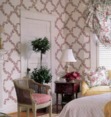

Scalamandré,
Lilabeth's
Ribbon, pattern number WP81571, c. 2002, silkscreen printed by hand using 10 screens, width 27 inches, the pattern repeats
vertically every 33 inches,
horizontally every 27 inches,
5 yards to a roll, shown in one of four available colorways.
Each is designed to complement
"Lilabeth Border" and "Lilabeth" printed
chintz, which can be seen in the enlarged photo of this room.
Also see chinoiserie, pattern, and tessellation.
ware - A collective term for pottery and ceramic objects.
warm colors - Colors are often described as having temperature — as warm (reds, oranges, and yellows), or cool (greens, blues, and violets). Warm colors are often associated with fire and the sun. They appear on one side of the color wheel, and opposite the cool colors. Psychologically, warm colors are said to be stimulating and passionate. Optically, warm colors generally appear to advance, coming toward the viewer.
Purple (red-violet) and yellow-green are between warm and cool. Don't call them "neutral," because neutral colors are grays, whites, and blacks. Meteorologists discuss the middling temperatures much more than than color theorists do. Following the lead of the weather-folk, if the color is as in-between warm and cool as it could possibly be, the most solid word is "temperate." "Mild" leans slightly more toward warm than toward cool — this would be appropriate for a certain yellow that is somewhat green, or a certain red that is somewhat violet, but not for the utterly in-between colors.Other words are problematic in other ways, often for suggesting value judgments, and those would (or might) be unwanted. ArtPage generally avoids prescriptive judgments, preferring to report patterns in art speakers' and writers' behaviors. Nevertheless, if we had to choose a word for the colors that are absolutely balanced between warm and cool, temperate is that bon mot. Contact to report what word you use, or someone uses for in-between-warm-and-cool colors.
Also see analogous colors, chroma, complementary colors, earth colors, hue, shade, and tint.
warp - In weaving, the vertical threads attached to the top and bottom of a loom, through which the weft is woven.
An ancient example:

Egypt, Thebes, Sheet of Royal Linen, c. 1466 BCE,
Dynasty 18, reign of Hatshepsut 6-7, linen,
greatest width 63 3/8 inches (161
cm), greatest length 16 feet
11 inches (515 cm), weight 2.9 ounces (140 g), 118 warp
and 77 weft threads per square
inch (46 warp and 30 weft threads per square cm), Metropolitan
Museum of Art, NY. See Egyptian
art.

washer - A flat metal or rubber disk placed beneath a bolt head or nut which helps to secure the bolt and distribute its pressure, lessen friction, or prevent leakage.
waste mold - This term is used in two contradictory ways. In its most common use: a piece mold made from a model (usually of clay or wax) when the model must be broken apart (wasted) in removing it from the mold. The other use: a mold from which only one cast can be taken, because the mold must be broken apart and discarded in order to release the cast. This is how lost-wax casting casting is accomplished, for instance. The use of this term is highly problematic then, unless the user immediately explains the meaning intended.
Also see release agent.
water feature - A category of environmental subjects (often in architecture and landscape architecture) which might include any natural or artificial body of water, whether still or moving. Fountains may be the most renowned artificial water features. People are attracted to water. it tends to absorb our attention.
Also see feng shui.
water gilding - The application of gold leaf to a surface of gesso (or whiting) which may have been coated with bole, and this covered with a water and glue. The gold is then burnished. This is a better technique than oil gilding (also known as mordant gilding), when the surface is a gessoed one, although it is more difficult.
Also see fire gilding, gilt, and glair.
watermark - In the making of paper, a translucent design impressed on it when still moist by a metal pattern, and visible when the paper is held before light (back-lit). In digital imaging, bits altered within an image to create a pattern which indicates proof of ownership; so that unauthorized use of a watermarked image can then be traced.
Example:

![]()

![]()
Andrew Ward (British, contemporary), designer,
Bank of England, £10 banknote, 2000, engraving on paper.
The oval feature in the center
of the note contains a watermark of Queen Elizabeth II, overprinted
by a fine tint. This feature
should hardly be apparent until held up to the light.
Then a clearly defined multi-tone portrait of the Queen, with
subtle gradations of light and shade,
is visible. See numismatics.
Related link:
waterproof - Typically refers to colors or other materials which will not decay or distort with exposure to water. The most common waterproof materials are various waxes, rubbers, plastics, and sealing agents.
Also see encaustic, feather, fugitive colors, permanent, permanent pigment, lightfast, and water-soluble.
waterscape - A painting of or including a body of water. It might otherwise be called a marine picture, a seascape, or a riverscape, etc.
water-soluble - Soluble in water; capable of being dissolved in water, especially if a wetting agent is added, like detergents and soaps. For all water-soluble media, water is the solvent.
Also see aqueous, blot, cleaning art, clean up, dye, eyedropper, incrassate, miscible, stain, vehicle, watercolor, and waterproof.
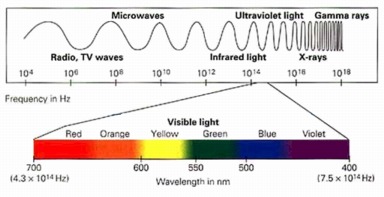
wavelength - The distance between one peak or crest of a wave of light, heat, or other energy and the next corresponding peak or crest. In that light has qualities of waves, the various colors of the visible spectrum differ in the length of their waves, from violet at 400 nanometers to red at about 700 nanometers. Just shorter than violet's wavelength is that of ultraviolet light and then x-rays, both beyond the abilities of human eyes to see. Similarly, longer than red's, and invisible to the unassisted human eye is infrared. Wavelengths are usually measured in units of nanometers (nm) or of angstroms (Å). 1 nanometer = 10 angstroms.
Also see refraction, rhythm, and temperature.
wax - Any of various natural, oily or greasy heat-sensitive substances, including beeswax, ceresin, carnauba, tallow, paraffin, and micro-crystalline wax. Most waxes consist of hydrocarbons or esters of fatty acids that are insoluble in water but soluble in most organic solvents. Ozocerite or paraffin is a solid, plastic or liquid substance, a petroleum byproduct, used in coating paper, in crayons, and other products. Both natural and synthetic waxes are used in painting as binders, and as an important ingredient in candles and polishes. They are also important materials used for carving and modeling, generally over an armature, and in casting.
Solvents used to dissolve various waxes include alcohol, acetone, benzine, turpentine, ether, and carbon tetrachloride. Waxes are often softened for carving or modeling by heating in a double boiler or with a light bulb, by sculpting with tools warmed over an alcohol lamp, or by the use of soldering irons, alcohol lamps, and blowpipes. Wax can be melted for casting in a double boiler. Additives used with waxes include rosin, dyes, petroleum jelly, mineral oil, and many solvents.
Avoid synthetic chlorinated waxes. They
are too hazardous to use for
art purposes, because they can cause a severe form of acne (chloracne)
or worse: many contain polychlorinated biphenyls (PCBs), which
can cause fatal forms of cancer.
Overheating wax can result in
the release of flammable wax
vapors, as well as in the decomposition of the wax to release
acrolein fumes and other decomposition products which are highly irritating by inhalation.
Explosions have occurred from heating wax that contained water.
![]() Alcohol and acetone are slightly toxic
solvents by skin contact and
inhalation; benzine and turpentine
are moderately toxic by skin contact, inhalation, and ingestion.
Carbon tetrachloride is extremely toxic, possibly causing liver
cancer and severe liver damage, even from small exposures. Exposure
to carbon tetrachloride can be fatal by skin absorption or inhalation.
Alcohol and acetone are slightly toxic
solvents by skin contact and
inhalation; benzine and turpentine
are moderately toxic by skin contact, inhalation, and ingestion.
Carbon tetrachloride is extremely toxic, possibly causing liver
cancer and severe liver damage, even from small exposures. Exposure
to carbon tetrachloride can be fatal by skin absorption or inhalation.
An example of a work in wax:

Annibale Fontana (Italian, Milan, 1540[?]-87),
Adoring Angel, 1583-84, wax with metal armature
on wood base, height
(with base) 21 3/4 inches (55.2 cm), Los Angeles County Museum
of Art.
Also see batik, encaustic, imagines, incrassate, lost-wax casting, melting point, miscible, resin, sincere, sprue, stain, stain removal, stearin, temperature, and vehicle.
waxwork - Modeling in wax. Or a figure made of wax, especially a full-scale wax effigy of a famous person. Also, the plural form, used with either a singular or plural verb, refers to an exhibition of wax figures in a museum.
Also see effigy.
weal - See scarification
weaving - The interlacing of long, thin materials, such as yarn or thread to make cloth (fabric) or baskets.
Also see costume, fiber, tapestry, tartan, textile, warp, weft, and wove paper.
Web - See World Wide Web (WWW).
webbed - In sculpture, the retention of a supporting membrane of material between fingers or other thin extremities, especially in stone sculpture.
Also see marble and structure.
web press - In printing, a rotary press that prints on a long roll of paper.
webucation -
Quote:
Also see art degree, assessment, Bloom's Taxonomy, educator, effort, knowledge, motivation, new media, standards, tradigital, and World Wide Web (WWW).

wedge - A piece of material, such as wood or metal, tapered at one edge and thick at the opposite end, used for tightening, securing, levering, or splitting, as when driven into wood along its grain, or when driven into the interlocking corners of wooden stretchers to produce tension on canvas support. These last are also called keys.
Also see arch, cuneiform, stave, and voussoirs.
![]()
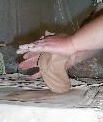
![]()
wedging - A technique in which clay is thoroughly kneaded and cut before use in modeling or pottery, to make it plastic and remove air pockets.
weft - The threads or strands of yarn that are woven over and under the warp threads to make a weaving. A less commonly used equivalent term is woof.
An ancient example:

Egypt, Thebes, Sheet of Royal Linen, c. 1466 BCE,
Dynasty 18, reign of Hatshepsut 6-7, linen,
greatest width 63 3/8 inches (161
cm), greatest length 16 feet
11 inches (515 cm), weight 2.9 ounces (140 g), 118 warp,
77 weft per square inches (46 warp, 30 weft per square cm), Metropolitan
Museum of Art, NY. See Egyptian
art.
Also see textile.
weight - Either the actual (physical) or the apparent (visual or compositional) heaviness of an object. When referring to the actual weight of an object, weight is a measurement of the force with which that object is attracted to earth (or some other celestial body) in such units as grams, kilograms, pounds, ounces, and stones. When referring to the visual or compositional weight of a portion of an image, weight is the relative visual dominance, emphasis, pull or force of attraction of that portion (object, volume, etc.) of a composition (picture, sculpture, etc.) The weight of a portion of a composition can depend in part upon such factors as its location (arrangement) in a composition, the extent of its isolation from other parts (distance from or contrast with other parts), and the psychological pull of its meaning. Human faces and other parts of figures, for instance, typically attract the viewer's gaze more powerfully than most other subjects.
(pr. wayt)
An example of an object whose function was to provide weight:

Mesopotamia, Weight in the Shape of a Sleeping Duck, c. 2000 - 1500 BCE, carved limestone, length 35.2 cm — an unusually large size, private collection, Europe. The massive and highly stylized bird is shown with a plump body and flaring tail, and easily transcends its original and somewhat prosaic function. The head, on an elongated neck, is turned to rest on the back. The simplified contours combine with the tactile surface invite comparison to sculptures by Constantin Brancusi and other modern sculptors. See Mesopotamian art .
Quote:
Also see balance, other principles of design, contrapposto, counterpoise, direction, focal point, juxtaposition, science and art, and tension.
weight shift - See contrapposto.
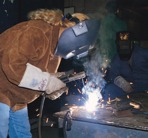
welding - The process
 of
joining metals
by fusing them together under
direct, intense heat. A commonly used source of heat for welding
is an oxyacetylene torch. A metal rod may be applied to the joint which melts into any gaps
and strengthens the bond.
of
joining metals
by fusing them together under
direct, intense heat. A commonly used source of heat for welding
is an oxyacetylene torch. A metal rod may be applied to the joint which melts into any gaps
and strengthens the bond.
Examples of welded sculptures:
Anthony Caro (English, 1924-), Potpourri, 1976-77, welded steel, rusted and varnished, 57 x 102 x 134 inches, Grounds For Sculpture, NJ. See English art.

Anthony Caro, Odalisque, 1984, steel, 77 x 96 x 60 1/2 inches (195.6
x 243.8 x 153.7 cm), Metropolitan Museum of Art, NY. See odalisque.
Also see acetylene and solder.
Weltanschauung - See world-view.
(pr. VELT-on-SHAH-wəng)
Western Jin Dynasty - A Chinese dynasty from 265 - 316 CE. (Not to be confused with the Jin Dynasty period which lasted 1115 - 1234.)
wet-and-dry paper - Paper with a coating of silicon carbide, used as an abrasive; a type of sandpaper. Its common name derives from the fact that it can be used wet or dry, as suitable with the materials abraded and the surface finish required.
wet collodion - See collodion wet plate.
wetting agent - A substance that reduces the surface tension of a liquid, causing the liquid to spread across or penetrate more easily the surface of a solid, making anything that is water-soluble more quickly solved. Detergents and soaps generally accomplish this in order to penetrate surfaces to clean them. A wetting agent traditionally used in watercolor painting is oxgall. Modern synthetic wetting agents most recommended for art applications are often available from art supply dealers and from photographic and general chemical supply dealers in bottle, dropper-bottle, and aerosol forms.
Also see aqueous, caustic, clean up, consistency, hazardous, miscible, solvent, vehicle, viscosity, and volatile.
wheel window - See rose window.
whirligig - A toy that spins — a carousel (merry-go-round) for example, or a thing that continuously whirls in a breeze, often placed on a lawn or a roof. It is mechanical, with some type of propeller. It may be part of a weather vane.
(pr. WHəR-lee-gig)
Example:

American, Whirligig: Black Man Swatting at a Large Bug, height 18 inches, polychromed wood and tin 19th century, found in a Farmington, NH home.
Other resources about whirligigs:
Typically a form of folk art. Also see dance, decorative arts, and rhythm.
![]()
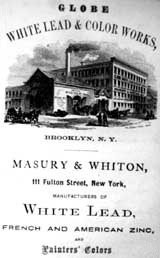
![]()
white lead - White lead, a whitish corrosion product
of lead, was formerly used
to provide opacity in paints,
especially in house paints. The white pigment
in a colored paint is often called the hiding
pigment. In addition to preventing the sun's damaging rays from
affecting the surface beneath
the paint, the white lead also helped
prevent the growth of mold and mildew. Not until early in the
20th century was a successful substitute, titanium
dioxide (TiO2), patented, and even then, it did not come into
prevalent use by itself until the middle of the 20th century.
Earlier in the century, titanium oxide and white lead were often
mixed.
Also see zinc white.
white spirits - See mineral spirits.
whiting - Ground and dried chalk used in plate cleaning and in the preparation of gesso.
Also see body color and gouache.
wide-angle, wide-angle lens, wide-angle shot - Wide-angle refers to a view that has or covers a field of vision (an angle of view) wider than the ordinary, to an angle of 50° or greater, as when seen through a lens of shorter than normal (50 mm) focal length. An effect of a wide-angle lens is to make subjects appear smaller or further away than they really are, and can be seen as distortion. Using a camera having a wide-angle lens is called taking a wide-angle shot. A panoramic photograph (150°-360° wide) is one kind of wide-angle image. Another extreme type can be produced with a fish-eye lens (about 180° in all directions). The opposite of a wide-angle is telephoto, the opposite of a wide-angle lens is a telephoto lens, the opposite of a wide-angle shot is a telephoto shot. In cinematography or video photography, the need for a wide-angle shot might be satisfied with either a panning or a tracking shot.
Also see anamorphosis, anamorphic art, aspect ratio, landscape, and point of view.
![]()

![]() width -
The second dimension, after
height. Width is usually the
measurement of the extent
of a shape or a space
from side to side. Alternatively, when considering such a two-dimensional material
as a piece of fabric, width is the second greatest dimension — after length (as opposed to
height), and before thickness (as opposed to depth).
width -
The second dimension, after
height. Width is usually the
measurement of the extent
of a shape or a space
from side to side. Alternatively, when considering such a two-dimensional material
as a piece of fabric, width is the second greatest dimension — after length (as opposed to
height), and before thickness (as opposed to depth).
Also see aspect ratio, horizontal, kerf, wide-angle, wide-angle lens, and wide-angle shot.
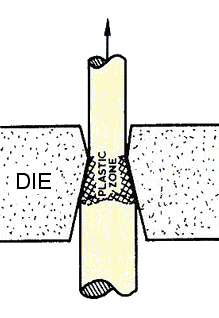
wire - A usually pliable metallic strand made in many lengths and diameters (gauges), sometimes clad or coated with insulation, as are electrical wires. (See a table of wire gauges and their equivalents expressed in inches.) A group of wire strands twisted or braided together as a functional unit is called cable.
Wire is made or reduced in diamater, known as gauge, by pulling metal through a series of progressively smaller holes in a die. "Plastic zone" in this diagram refers to the section of metal actively changing.
Because a bad tangle can be a disaster, it is wise to give children access only to smaller spools taken from a large one.
![]() Safety concerns with wire:
Safety concerns with wire:

Examples of works in which wire is important:
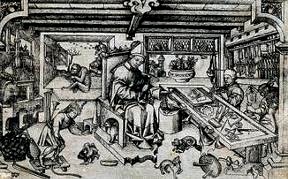
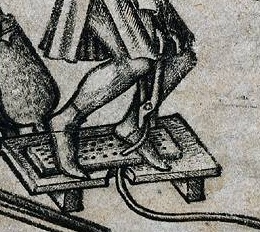
Master of Balaam (Dutch), St. Eligius in His Studio, c. 1450, engraving on paper, 11.5 x 18.5 cm, Rijksmuseum, Netherlands. St. Eligius, patron saint of blacksmiths, jewelers, and metal workers is working in a metalsmiths workshop. As he hammers a goblet into shape on his anvil, three other people are working in the studio: a master smith and two apprentices, one of whom is producing wire.
A detail of the picture shows the wire maker using a pair of tongs to pull a bar of metal through a die that is a perforated plate." The metal is drawn through a smaller hole each time, until it is of the desired thickness.

Antoine Pevsner (French, born Russia, 1886-1962),
Maquette of a Monument Symbolising the Liberation
of the Spirit, 1952, bronze,
18 x 18 x 11 1/2 inches (4.6 x 4.6 x 29.5 cm), Tate Gallery,
London. See Constructivism and maquette.

Kurt Schwitters (German, 1887-1948), Red Wire Sculpture, 1944, painted metal, stone,
mixed media, 25.0 x 13.0
x 13.0 cm, Tate Gallery, London. See Dada
and found material.

Alexander Calder (American, 1898-1976), Romulus and Remus, 1928, wire and wood, 30 1/2 x 124 1/2 x 26 inches, Solomon R. Guggenheim Museum, NY. See sculpture.

Alexander Calder, Goldfish Bowl, 1929, wire, private collection.See mobile.

Wayne Eagleboy (American, Onandaga tribe, contemporary), We the People, 1971, acrylic paint and barbed wire on buffalo hide, Art Wagon Gallery. Contemporary Native American Wayne Eagleboy's version of the US flag bears portraits of two Indian men behind a screen of barbed-wire. The barbs have been substituted for the stars of the official design. The painting is framed with the fur attached to its reverse.

Tim Hawkinson (American, 1960-), Shorts, 1993, woven electrical extension cord, ACE Gallery, NYC. The artist has worn these shorts. See costume.
Also see armature, basket, filigree, and jewelry, as well as the names of various metals, techniques, etc., along with kinetic, laid and wove papers, marionette, mobile, nail, openwork, plastic, puppet, staple, and wireframe.
wireframe - In digital imaging, a two-dimensional depiction of a three-dimensional object displayed as an interconnected straight-line segments — each edges of adjacent polygons. A wireframe looks much like a wire-constructed cage. A wireframe is most often used as the basis for the development of a more developed picture: a framework upon which to model a surface of varied values, colors, and textures. People who work with wireframes often shorten the word to "wires."
Examples:
![]()

![]()
Wireframe for a human head.

The same wireframe after a plain surface
has been added.
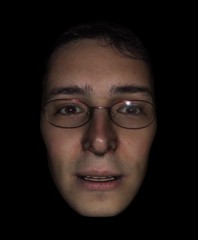
![]()
The same wireframe after this figure's surface has been fully modeled. Among
the alterations that have been made: eyeglasses have been added,
along with color, texture, shadows
and highlights, and the mouth
has been opened slightly.
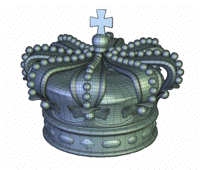
Royal Crown, 2003?, digital
image, showing a wireframe with a NURB surface,
produced with 3D modeling graphics software "Amapi Designer
7" from eovia.com.
See crown.
Other examples:
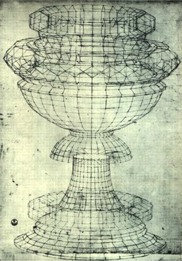
A precursor
from as long ago as the early Renaissance:
Paolo Uccello (born Paolo di Dono) (Italian, 1397-1475), Perspective
Study of a Chalice, pen
and ink on paper,
29 x 24.5 cm, Gabinetto dei Disegni, Uffizi, Florence. See chalice.
Click here to see a movie of another such head, fully modeled. (QuickTime, 544 kb)

Peter Jackson (New Zealander, 1961-) directing
a team of designers, Gollum,
a character in the motion picture trilogy the Lord of the
Rings, 2001-2003, a digitally produced animated
figure, based upon
the description by J.R.R.
Tolkien and the acting by Andy Serkis, New Line Cinema. This
tragically grotesque character
was created by a combination of modeling,
rotoscoping, and digitizing
techniques, including the production
and manipulation of a wireframe
figure. See cinema.
Also see vector graphic.
women's art - See feminism and feminist art and gender issues.
Seven Wonders of the Ancient World
wonder cabinet - See Wunderkabinette and Wunderkammer.
woodblock print - See woodcut.
woof - The threads or strands of yarn that are woven over and under the warp threads to make a weaving. The more common contemporary term is weft.
(pr. woof)
![]()

![]()
Works Progress Administration (WPA) - An agency of the U.S. Government during the Great Depression of the 1930s and 1940s. Its Federal Art Project (FAP) is one of the federal entities which administered New Deal art programs. Its name was officially changed to the Works Projects Administration after July 1, 1939.
world-view or worldview - The larger point of view one has, and from which one interprets the world. A collection of beliefs about life and the universe held by an individual or a group. Also, this is the English equivalent of the German term Weltanschauung — the mind-set or outlook of a particular group, whether aesthetic, ethnic, political, social, etc. Weltanschauungs (or Weltanschauungen) are usually limited in scope to readily identifiable historical, geographical, ethnic and other groupings.
About world-view:
Also see anthropocentrism, artist, chinoiserie, feminism and feminist art, gender issues, issue, style, and zeitgeist.
World Wide Web (WWW) - An interconnected network of electronic hypermedia documents available on the Internet. WWW documents are marked up in Hypertext Markup Language (HTML). Cross references between documents are recorded in the form of URLs. Tim Berners-Lee invented World Wide Web in 1989. A graduate of Oxford University, England, Tim Berners-Lee is now (2004) with the Laboratory for Computer Science (LCS) at the Massachusetts Institute of Technology (MIT). The Web is a major platform for new media.
Many visual artists have been involved in Web development — producing Web sites, pages, graphic and text components for the Web. This is called Web "development" rather than Web "production" because it's constantly in development — never entirely finished — unlike film production, which insinuates a beginning, middle and an end.
As the Web becomes ubiquitous in our lives, words for it are becoming common nouns. Thus we increasingly see "the web" and "the internet."
Also see advertising, color look-up table, graphic design, Java, logo, pixel shim, and webucation.
worm's-eye view - As if seen from the surface of the earth, or the floor. A variation on landscape, the horizon for a worm's-eye view is usually placed very low in the picture, or outside of it completely.
Examples:

Looking up from below the choir vault of
Amiens Cathedral, France. Also see Gothic
and cathedral.

A spiral staircase as seen from below.
A photograph
of such a helical structure,
when taken with a worm's-eye view turns a helix into another
kind of spiral: a volute.
Internet resources concerned with worm's-eye view:
Also see bird's-eye view, di sotto in sù, fish-eye lens, perspective, point of view, and wide-angle.
wove paper - The commonly seen gridded, patterned texture produced by paper pulp pressing against wires on the mold screen as the paper is made. Very different is the texture made by wires on laid paper.
Examples of works on wove papers:

Charles-Balthazar-Julien Févret De
Saint-Mémin (French, 1770-1852), Thomas Jefferson (1743-1826), third president
of the US (1801-1809), 1804, charcoal
and black, white and gray chalk
drawing on
cream wove paper prepared with pink background, Worcester Art
Museum, MA. See profile.

John
James Audubon (American, 1785-1851), Douglass' Squirrel, a study for pl. 48
of Viviparous Quadripeds of North America by John James
Audubon and Rev. John Bachman (New York: John James Audubon,
published 1845-1848), c. 1843, watercolor, ink,
graphite, and glaze
on wove paper, 12 1/4 x 9 1/2 inches (310 x 242 mm), Fine Arts
Museums of San Francisco, CA. See nature.

Honoré-Victorin Daumier (French, 1808-1879),
The Connoisseur, c. 1860-65, pen and
ink, wash,
watercolor, lithographic
crayon, and gouache over black chalk, wove paper; sheet: 17 1/4 x 14 inches
(43.8 x 35.5 cm), Metropolitan Museum of Art, NY. See connoisseur,
drawing, and
French.

William Trost Richards (American, 1833-1905),
Moonlight on Mount Lafayette, New Hampshire,
1873, watercolor,
gouache, and graphite on gray-green wove
paper, 8 1/2 x 14 3/16 inches (21.6 x 36 cm), Metropolitan Museum
of Art, NY. See nocturne.

Hilaire-Germain-Edgar Degas (French, 1834-1917),
Édouard Manet, Seated, 1866-68,
portrait of
Édouard Manet (French, 1832-1883), black chalk on off-white wove paper; sheet: 13 1/16
x 9 1/16 inches (33.1 x 23 cm), Metropolitan Museum of Art, NY.
See Impressionism.

Maurice Brazil Prendergast (American, born
Newfoundland, 1859-1924), Low
Tide, Beachmont, c. 1902-4, watercolor over graphite
and coal on off-white wove paper, Worcester Art Museum, MA.
Also see weaving.
WPA - Acronym for Works Progress Administration. It conducted the Federal Art Project (FAP). These U.S government entities are among the "alphabet soup" of federal projects which administered New Deal art programs.
writing - See art criticism, font, lettering, narrative art, and text.
wrought iron - An iron which is forged — formed by heating in a furnace and hammering, bending, etc. — and welded — joining two pieces of metal by applying heat, sometimes with pressure, and sometimes with an additional melted metal. It contains less than .3% carbon and 1-2% slag. Cast iron, on the other hand, is a more brittle, nonmalleable alloy of iron and carbon, which is shaped by from pouring it molten into a mold.
(pr. RAWT I:-ərn)
An example:

Spanish Colonial California, workshops of
San Fernando, Iron Grille, wrought iron, as rendered
by William Kieckhofel, 1941, watercolor, colored pencil, and graphite on paper,
.368 x .266 m (14 1/2 x 10 7/16 inches), Index of American Design,
National Gallery of Art, Washington D.C. The ironworkers of San
Fernando were predominantly American
Indian, although the design of this window grille is typical
of Spain.
Another resource concerning wrought iron:
Also see openwork, temperature, and welding.
Wunderkabinett and Wunderkammer - A Wunderkabinett is most literally a "cabinet of wonders," and a Wunderkammer is a "chamber of wonders," exhibition spaces in which miscellaneous curiosities — odd and wondrous rarities — brought together for private contemplation and pleasure. These words are German, but they are also used by speakers and writers of English because so many of the earliest (16th century) and best examples have been German. The objects on display in these storage/display spaces were marvels of nature. If some or all of the objects were art, then they were more likely to be called Kunstkabinetts and Kunstkammern instead. These precursors of the museum were developments of the Renaissance. The museum, on the other hand, was a creation of the Enlightenment. A rule in writing German is that the first letter of every noun must be capitalized (common as well as proper nouns), so the W's in these words are usually capitalized in English texts. The plural of Wunderkammer is Wunderkammern.
Wunderkabinetts and Wunderkammern very rarely remain today as they were in previous centuries. They are simultaneously pieces of furniture and the collections of objects within them, and naturally the selections of things in them were placed and replaced as their owners decided. The Getty Museum is justly proud of its empty cabinet (and title it Display Cabinet) because this exemplar remains so evocative of the great wonder its viewers must have taken in its presentation.
Examples:
German (Augsburg), 1620-30, Display Cabinet, including three carvings by Albert Jansz. Vinckenbrinck (Dutch, about 1604-1664/65), ebony, chestnut, walnut, pearwood, boxwood, ivory, marble, semiprecious stones, enamel, palm wood, and tortoiseshell, 28 3/4 x 22 7/8 x 23 1/4 inches, J. Paul Getty Museum, Malibu, CA. This is one of 22 devices in the Devices of Wonder exhibit cataloged online by the Getty Museum — best seen with Flash and RealAudio plugins. See wood.

German, Wunderkammer, 17th century, woodcut. This chamber presented a collection
of both art and natural objects. There is an alligator above,
displayed as if it were walking on the ceiling!
Related links:
Also see base, Collyers' Mansion, frame, gallery, shadow box, and vitrine.
WYSIWYG - An abbreviation in computer graphics and digital imaging for "What You See Is What You Get," meaning that what you see on your monitor is what will be seen later — on other monitors, or printed, or on the World Wide Web (WWW), etc.
Also see aspect ratio.
https://inform.quest/_art